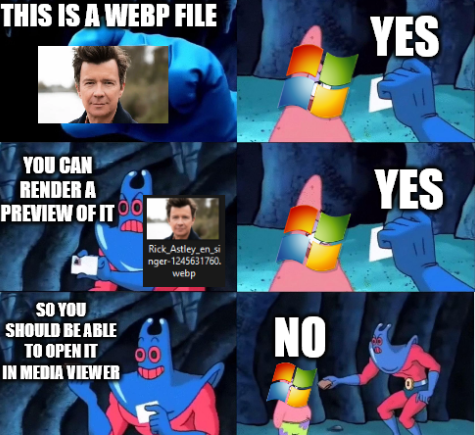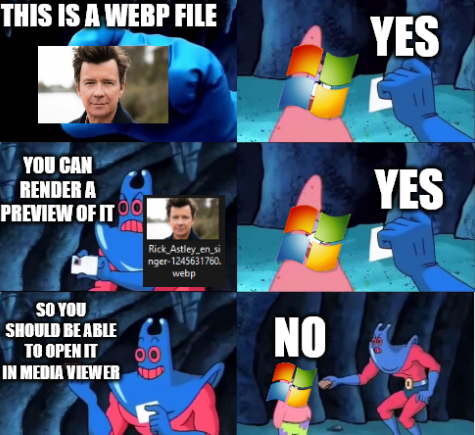I know nothing about computers but this does not add up
-
Look, I was a big fan of HEIF but these days I just want anything better than PNG and fucking JPEG, GIF.
Apple: “Might I interest you in HEIC?”
-
I kept a copy of the old Windows XP version of media viewer/pictute viewer, whatever the hell its generic name was becsuse at some point in, IIRC, Vista, they updated it to some piece of garbage that had an uglier UI, worked slower, had no options for slideshows, and didn't even support shit like animated .gifs.
Even that old ass program can open a .webp image.
What the hell, seriously?
-
This post did not contain any content.
I remember when you could’ve made this meme about PNGs.
-
I guess it's Windows users with the default image viewer. IrfanView on W10 handles webp fine for me.
So does XnView, both Windows and Linux.
-
taking a screenshot can solve some of this problem
I just rename it to a ".JPG" file extension and that seems to work ¯_(ツ)_/¯
-
It is though. So many websites have converted their embedded feeds ti show a webp version regardless of what you upload.
-
I kept a copy of the old Windows XP version of media viewer/pictute viewer, whatever the hell its generic name was becsuse at some point in, IIRC, Vista, they updated it to some piece of garbage that had an uglier UI, worked slower, had no options for slideshows, and didn't even support shit like animated .gifs.
Even that old ass program can open a .webp image.
Yo that was an absolute joke. Were they serious with that?
Windows handled gifs fine for years then suddenly only the first frame. Seriously?!
-
what would they be?
do you mean in sense of lossy or lossless? if so, in theory both webp and avif could have lossless photos, but i do not think they are designed for that (think in terms of their backrounds, they are kinda like a single frame videos. and usually you only have lossy video).
jpeg xl in theory aims to take job of both jpeg and png (it can handle lossy as well as lossless). In theory, we (as in all of computing and media people) decide to back on jpegxl, we could potentially just have 1 format, and accordingly 1 library which provides support. but that is just a dream i do not see happening. google essentially paralysed jpeg xl by removing it from chromium , and that is the largest userbase.
almost all other big companies want to use jpeg xl. meta, adobe, intel and others. the main benefit to them is reduced bandwidth cost (for exactly same data, jpeg xl can be ~20% smaller than jpeg), and jpeg can be losslessly translated to jxl, and even for backwards compatibility, reverse can be done on client end. but without chrome, no web developer will adopt. if web people do not, the demand for format would be extremely small, no hardware manufacturer will include hardware support (your gpus have "special" stuff for almot all codecs and formats, but that is not the case for jxl for now), so jxl operations currently are slow, so end user might not even be motivated to use (other than space savings).
what would they be?
This is more or less everything I know about how image formats work.
-
I remember when you could’ve made this meme about PNGs.
And in a SANE world, somebody who learned a lesson would be using their knowledge so we don't keep repeating the same crap over and over again.
-
I remember when you could’ve made this meme about PNGs.
Back when Windows 3.1 only supported BMP and maybe JPG
-
It already happened years ago. It's supported and widely used. Why do people keep posting this misinformational meme?
-
What are the odds I happen to be watching Mean Girls on Pluto when I scroll across this meme.
-
what would they be?
This is more or less everything I know about how image formats work.
okay. it is a lot simplified, but mostly correct. ideally image format for drawn out stuff and other flat animated stuff is svg (vector graphics - ie - infinitely scalable yet crisp), but png is usually used because it is defacto lossless standrad. lossless here roughly translates to - sensor produced a matrix of colors - lossless photo preserves all data. lossy discards some data. For irl stuff, usually lossless is overkill for end user, hence you see jpegs (defacto lossy standrad)
jxl can so both. others can do that as well. jpegs can be lossless, but that is usually not the standard we use. you can store lossy data in pngs, but the loss is not created by png. jxl behaves by default like lossless (like png), but due to newer algorithms, size when lossless is closer to jpeg. if you prepare loss jxl - it can be close to half size of jpegs.
there are other benifits to jxl (extreme future proofing (extremely high bit depth, and pixel size limit, large amount of channels), progressive decoding, etc.), but our reality has to suck because of google.
I locally use jxl to store family photos, but this means i can not send them, because they are using stuff which does not support jxl, so have to convert and share.
-
I work in big tech and this is my life. I envy anyone who thinks you're exaggerating, because that means they haven't experienced the joy of spending weeks trying to track down the team responsible for a bug and then months hassling them to fix it.
And if they do talk to each other, the different departments need to go through the whole hierarchy for everything and each manager puts their spin on it, so you get answers back from questions that were not asked.
-
And in a SANE world, somebody who learned a lesson would be using their knowledge so we don't keep repeating the same crap over and over again.
It's Microsoft you are talking about here
-
Do the traditional JPG vs PNG usage "rules" apply to AVIF and JPEG XL?
IMO AVIF works really well at making convincing looking results at really high compression ratios, it's worse at pretty much everything else.
And occasionally the 'convincing looking' results aren't actually very accurate to the original image...
But those results really do look very convincing.
And IMO one of the most compelling features of JPEG-XL is its' great lossless compression, although it is generally good all-around. AVIF is pretty terrible at lossless compression, usually well-behind WebP and only a bit better than PNG.
Anyways, for photos, if you want to compress them a ton then maybe AVIF is best, but if you want high quality JXL is probably best.
I think https://cloudinary.com/blog/jpeg-xl-and-the-pareto-front is a good comparison
-
And as per usual, VLC seems to somehow have all the codecs already.
pot player as now my daily driver instead of VLC.. It has so many features that VLC is lacking. Willl convert any audio stream to subtitles or another language.
convert subtitles to audio in any language
fantastic multi-monitor support.
-
And if they do talk to each other, the different departments need to go through the whole hierarchy for everything and each manager puts their spin on it, so you get answers back from questions that were not asked.
Here's a real and true story about how separate Microsoft teams communicate and coordinate:
Few weeks ago, some Microsoft team from the US deprecated some critical service used by other Microsoft products. They just shut it off without notifying anyone. Other teams from other Microsoft offices in the rest of the world found about this deprecation when their production builds started failing to log customers in to the applications that they need for their businesses. People were called in from their vacations, emergency meetings were held to play hot potato with responsibility. Clients were PISSED. I stopped following the drama before it was resolved.
-
Back when Windows 3.1 only supported BMP and maybe JPG
Fancy pants over here with their pictures and color.





